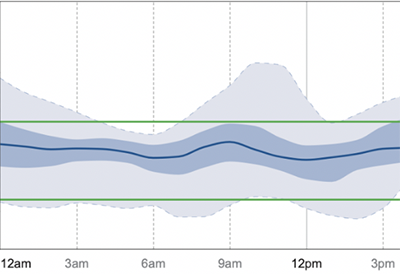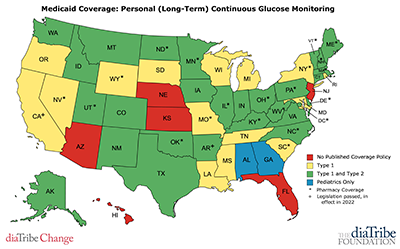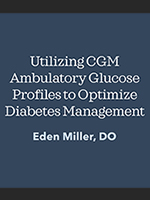Resource Toolkit for “Common Questions on Continuous Glucose Monitoring in Primary Care”
- American Diabetes Association Time in Range

The ADA’s Time in Range initiative will provide guidance on treating your patients with diabetes who might benefit from time in range. Visit often to register for their series of webinars, download the latest podcasts, and receive clinical pearls through their video series.
-
What Is a CGM (Continuous Glucose Monitor) and How Do I Choose One?
"As a reminder, CGM stands for “continuous glucose monitor.” Even those familiar with the term can find it challenging to figure out what a CGM does exactly, how to choose the right one, how to determine cost and insurance coverage, and where to buy one. Enter this DiabetesMine primer on continuous glucose monitoring."
One of the unique aspects of this article from Healthline.com's DiabetesMine is that it gets specific about pricing for uninsured patients, updated as of December 2021. Lots of other great information here, too, including an overview of what's available, and as the article's title promises, how patients can choose the right one for them.
- Accessing Data from CGMs
Your patient can share data with you, often via apps, or can bring in printed AGP reports. For those looking for more data, many devices offer clinicians additional options. Links to company resources for healthcare providers are below.
- Making the Most of CGM: Uncover the Magic of The Ambulatory Glucose Profile
Among the most important tools for both clinicians and patients is the Ambulatory Glucose Profile (AGP), an overlay of one month’s CGM data that shows at a glance how much time has been spent with blood sugars in the target range (70 to 180 mg/dL), as well as time above and below that range. This article from DiaTribe offers a fast, clear overview on what the AGP is, how to read it, and how critical it is to successful diabetes management. Troublespots are easy to identify when you can actually see them!

-
AAFP TIPS: Continuous Glucose Monitoring (CGM): Enhancing Diabetes Care, Workflows, Education, and Payment
- This accredited program (up to 2.0 Prescribed Credits) is an in-depth introduction to Continuous Glucose Monitoring (CGM) and will help practices learn which patients may benefit from CGM, evaluation patient readiness for technology and includes a multitude of resources for practices as well as patient education. This course also covers practice-level strategies for implementation of CGM into diabetes care, including team roles and workflows, billing and coding, EHR documentation and authorization. It is free to all AAFP members.

- CGM and Medicaid: Who’s Covered?
“It depends. In states that have expanded Medicaid, more people with diabetes are able to access Medicaid coverage benefits, which may include CGM access depending on the state. But even if CGM is covered under your state’s policy, each state has its own criteria for which individuals qualify to receive it. For example, some states only cover CGM for type 1 diabetes, and other states have differing policies for short-term and long-term CGM use.”
This article from DiaTribe is your one-stop overview of options for all 50 states, with links galore to enlighten every aspect of this potentially daunting set of questions.

- Utilizing CGM Ambulatory Glucose Profiles to Optimize Diabetes Management
A CME article by Dr. Eden Miller, DO, Executive Director and Co-Founder, Diabetes Nation, Diabetes and Obesity Care, Bend, Oregon. (Note that link will open a PDF in a new window.)
This article is certified for AMA PRA Category 1 Credit™ from organizations accredited by ACCME. After you've watched, visit this link to complete the survey for your credit, valid through July 31, 2022.

- American Association of Clinical Endocrinology (AACE) deck on CGM (PDF)
This slide deck covers both the importance of controlling glycemic variability to keep blood sugars within the targeted range in order to limit diabetic complications, and the limitations of the hemoglobin A1c measurement as a marker for control. As it proceeds to discuss the advantages of continuous glucose monitoring (CGM) over finger-stick monitoring, the presentation also covers all currently approved CGM devices, providing clear insights into the features that each offers for patients and clinicians, as well as a wide range of studies showing how quickly and how thoroughly CGM shows improvement in glycemic control outcomes.
Please note that the PDF will open in a new window, and depending on your connection, you may experience a slight delay while the file opens.
- Case Studies in Continuous Glucose Monitoring
Watch this CME/CE/CPE-certified video module and learn from case studies how to optimize outcomes in persons with diabetes using continuous glucose monitoring. Topics include:
- Overview of continuous glucose monitoring (CGM) systems
- Current recommendations on CGM
- Example of a CGM summary in a healthy person
- Cases demonstrating key points for using CGM
This educational activity provided by the Endocrine Society in collaboration with the ADCES Association of Diabetes Care and Education Specialists, and is certified for 0.5 AMA PRA Category 1 Credits™ (for physicians) and 0.5 Nursing contact hours (RNs) through August 29, 2022.
You may also download the PowerPoint slides from the program for self-study or to use in your noncommercial presentations.
- Webinar: “Common Questions on Continuous Glucose Monitoring in Primary Care”
For the clinicians who attended a state chapter or NPACE presentation on this topic, this is an opportunity to review the presentation. For those who came to the toolkit from the article in "Hot Topics in Primary Care," this is a chance to earn additional CME credit and learn more about the topic.
Join us for this fast-paced, highly engaging presentation on why A1c is not enough, and how continuous glucose monitoring (CGM) can empower both you and your patients to take easy, actionable steps toward better diabetes control.
This presentation is accredited for 1.0 AAFP Prescribed Credit, with an optional additional 2.0 AAFP t2p® (Translation to Practice®) credits. Details in the video and below.
- Get your CME credit for watching the video!
Don't forget to fill out the survey, including your email address, if you would like to receive CME credit for watching the video above. In addition to the 1.0 AAFP Prescribed Credit, an additional 2.0 AAFP t2p® (Translation to Practice®) credits will also be offered to those learners who wish it. In addition to letting us know in the survey link that you'd like to receive the additional t2p® credits, you'll need to participate in a follow-up survey to talk about the changes you've made as a result of the presentation.
So start here, and keep going!